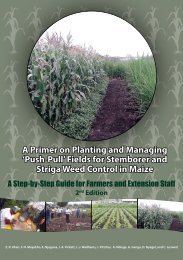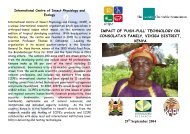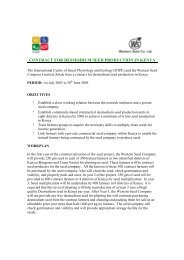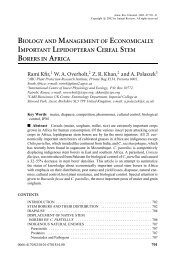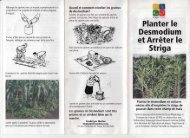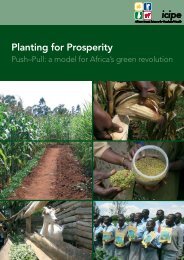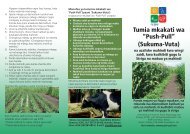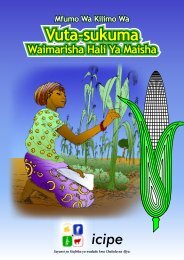The Royal Society Report - Push-Pull
The Royal Society Report - Push-Pull
The Royal Society Report - Push-Pull
You also want an ePaper? Increase the reach of your titles
YUMPU automatically turns print PDFs into web optimized ePapers that Google loves.
system and the benefits of P acquisition. Variation in the<br />
length and density of root hairs is important for the<br />
acquisition of immobile nutrients such as phosphorus and<br />
potassium. Genetic variation in root cortical aerenchyma<br />
formation and secondary development (‘root etiolation’)<br />
are important in reducing the metabolic costs of root<br />
growth and soil exploration (Lynch 2007).<br />
Lynch has argued that genetic variation in these traits is<br />
associated with substantial yield gains in low-fertility soils<br />
and that crop genotypes with greater yield in infertile soils<br />
will substantially improve the productivity and sustainability<br />
of low-input agroecosystems (Lynch 2007). In high-input<br />
agroecosystems, these traits will reduce the environmental<br />
impacts of intensive fertilisation.<br />
Engineering of nitrogen fixation into non-legume crops<br />
has been a long-standing target of biotechnologists.<br />
Three approaches have been envisioned. <strong>The</strong> first involves<br />
modification of crop plants so that they support symbiosis<br />
with a nitrogen-fixing bacterium or blue-green alga. <strong>The</strong><br />
second approach involves transfer of bacterial<br />
nitrogenase genes into the chloroplasts of crop plants.<br />
<strong>The</strong>se approaches are both still long term, there is little<br />
research activity in this area and it is unlikely that they<br />
could be harnessed to develop a nitrogen fixing crop<br />
within the next 15 years. A third approach is to move the<br />
plant genes required for production of a symbiotic<br />
nitrogen-fixing nodule from leguminous plants to others<br />
that cannot currently support such a symbiosis. As the<br />
plant genes required for nodule development become<br />
better understood, this prospect now appears less<br />
fanciful, but is still at least 10 years away (Markmann &<br />
Parniske 2009).<br />
3.3.5 Soils<br />
Intensive cultivation of soils damages soil structure and<br />
leads to overuse of groundwater resources. Soils become<br />
cracked, and seedbed preparation increasingly requires<br />
frequent ploughing. This damage both increases costs and<br />
reduces yield. Zero-till systems of production have been<br />
developed to address these problems. This requires a new<br />
generation of cheap and affordable machinery. Zero-till<br />
sites have reported increased yield, as well as evidence of<br />
reduced greenhouse gas emissions, fewer weeds, more<br />
beneficial insects and improved water use efficiency<br />
(Hobbs et al. 2008; see also Case study 3.6).<br />
Double digging is a method of deep soil preparation which<br />
can be used to improve soil fertility and structure. <strong>The</strong> idea<br />
of double dug beds is being widely promoted by local<br />
NGOs in Kenya. Double dug beds are combined with<br />
composts and animal manures to improve the soil. A<br />
considerable initial investment in labour is required, but the<br />
better water-holding capacity and higher organic matter<br />
mean that they are able to sustain vegetable growth long<br />
into the dry season. Once the investment is made, little<br />
more has to be done for the next two to three years. Many<br />
vegetable and fruit crops can be cultivated, including kales,<br />
onions, tomatoes, cabbage, passion fruit, pigeon peas,<br />
spinach, peppers, green beans and soya. <strong>The</strong> use of double<br />
dug beds in Kenya has improved food security. In<br />
particular, the health of children has improved through<br />
increased vegetable consumption and longer periods of<br />
available food (Pretty et al. 2003).<br />
Biochar (charcoal) addition to soils is an ancient practice<br />
which has recently begun to assume wider significance.<br />
As a by-product of the pyrolysis of plant-derived biomass<br />
(for energy generation without releasing carbon),<br />
incorporation of biochar represents a means of<br />
sequestering carbon (due to its long half-life in soil) and<br />
there is increasing evidence that it can also reduce<br />
nutrient leaching and impact on the slow release of<br />
nutrients to enhance crop yields (Marris 2006).<br />
Case study 3.6. Conservation agriculture in Burkina Faso, West Africa<br />
<strong>The</strong> predominant ecosystem type in southwest Burkina Faso is moist savannah with tropical grassland and widely<br />
spaced trees. This region is sometimes referred to as a potential breadbasket for Africa due to its high crop and<br />
livestock productivity potential. However, productivity is currently low across much of the region due to poor soil<br />
nutrient fertility, variable rainfall and inadequate biomass availability. Farmers usually grow a range of subsistence<br />
crops—mainly maize, pearl millet, sorghum, groundnut and cowpea.<br />
Over 20 million ha of savannah land (with similar agroecology to Burkina Faso) have been sustainably intensified and<br />
diversified in Brazil using conservation agriculture principles. From 2002 to 2007, an FAO conservation agriculture pilot<br />
study was carried out in five communities in Burkina Faso, with the following aims:<br />
• to expand crop choices to increase production of livestock feed;<br />
• to improve soil-crop-water management for sustainable production intensification; and<br />
• to diversify and expand the range of food, feed and tree crops and their integration with livestock into the existing<br />
cotton- and maize-based systems.<br />
What is conservation agriculture<br />
Conservation agriculture is resource-saving agricultural crop production that aims to deliver high and sustained<br />
production levels while conserving the environment. Interventions such as mechanical soil tillage are minimised (or<br />
34 I October 2009 I Reaping the Benefits <strong>The</strong> <strong>Royal</strong> <strong>Society</strong>



